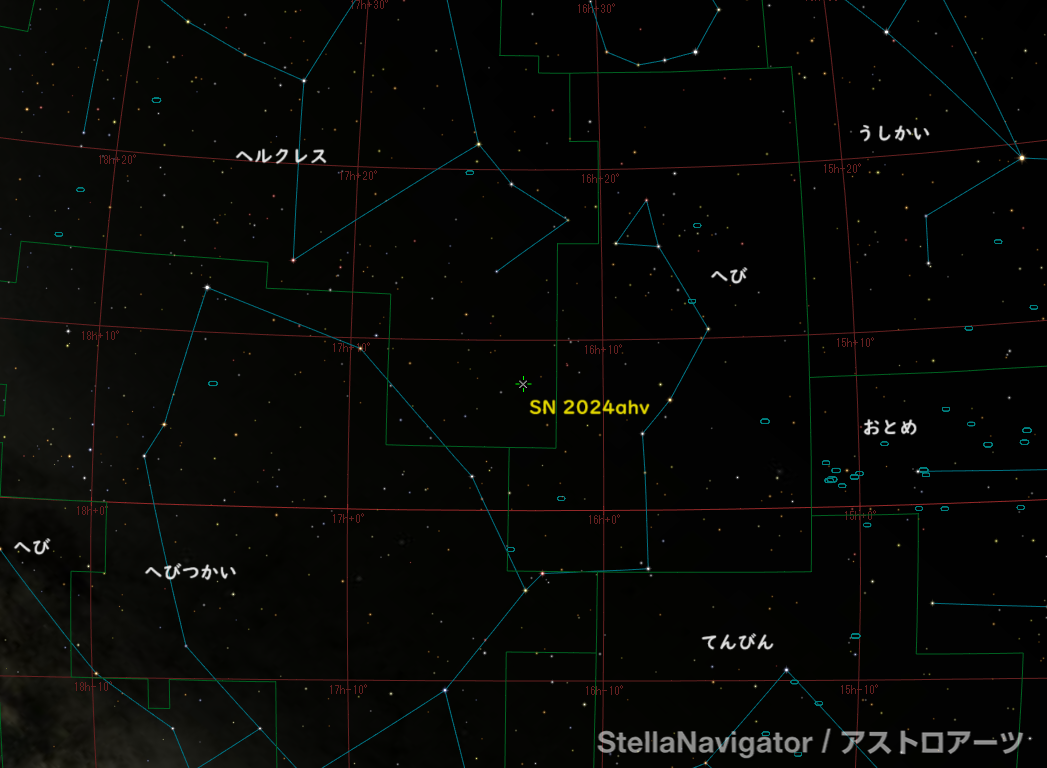星が好きな人のための新着情報
※あまりに古いリンク先は安全上リンクを外しています。
※固定リンクは星のアイコンに仕込まれています。
※更新は日付の前日の夜と当日の朝が多いです。掲載済の記事に後からリンクを追加することもあります。
2007年01月21日(日)
★ 【訃報】磯部琇三(しゅうぞう)氏
昨年12月31日に逝去されたとのこと。ご本人の強い希望により葬儀等は行われませんでした。- 日本スペースガード協会
★ 【動画】SOHOの視野を移動するマックノート彗星
- APOD: 2007 January 20 - SOHO: Comet McNaught Movie
★ 【画像】C/2006 P1 マックノート彗星
- Flickr: Comet McNaught C/2006 P1(thanks>Spiegelさん)
★ 三重連星のクエーサーが見つかった
- ケック天文台:First Triple Quasar Discovered at W. M. Keck Observatory
- アストロアーツ:正真正銘の「三重連星」クエーサー
★ JAXA、「きぼう」運用管制室を報道公開、また管理責任者を任命
報道より。- 時事通信:きぼう」管制責任者を任命=打ち上げに向け準備本格化−運用室も公開・宇宙機構
★ 松浦晋也氏の記事「やっと決まったLUNA-A中止」
- やっと決まったLUNAR-A中止 徹底した原因・経緯の調査が必要 - ビジネススタイル - nikkei BPnet
2008年01月21日(月)
★ 板垣公一さん、わい新星を発見
1月19.546日(世界時)の観測から、「こいぬ座」に12.3等のわい新星を発見しました。- CBET 1216
発見位置![[PNG/星図] [PNG/星図]](image/uploads/20080121_0.png) クリックで拡大 |
R.A.= 7h47m27s.64, Decl. = +6o50'50".0 (2000.0) CBET 1216 |
★ ブラックホールの内部を超弦理論で解明
高エネルギー加速器研究機構の研究グループ。- KEK:高エネルギー加速器研究機構
- ブラックホール:内部、超弦理論で解明 高エネ研、スパコン使い再現 - 毎日jp(毎日新聞)
★ サイエンスカフェinサイパル「IYPE(国際惑星地球年)と地球環境」
1月24日、旭川市科学館「サイパル」(北海道旭川市)。- 旭川市科学館・サイパル / サイエンス / サタデーサイエンスひろば
★ JAXAタウンミーティング in 阿南
「阿南発宇宙行き 〜プロフェッショナルと語る宇宙の最前線〜」。1月26日、阿南市科学センター(徳島県阿南市)。- JAXA|阿南発宇宙行き〜プロフェッショナルと語る宇宙の最前線〜「第23回JAXAタウンミーティング」 in 阿南の開催について
- 阿南市科学センター
★ 倉敷科学センター講演会「冥王星のその後 新しい太陽系像にせまる」
1月26日、講師:縣秀彦氏(国立天文台)。参加者募集中。- 倉敷科学センター : 広報リリース
★ 第5回 まくはりサイエンス・カフェ「宇宙科学リテラシー」
2月 9日、千葉県総合教育センター。- サイエンスカフェ・ポータル: 第5回 まくはりサイエンス・カフェ
★ 【APoD】チリから見たC/2006 P1 マクノート彗星
もう1年前の話です。- APOD: 2008 January 20 - Comet McNaught Over Chile
2009年01月21日(水)
★ 「いぶき」打ち上げは23日に
1月22日に延期されていましたが、気象条件の改善が見込めないのでさらに延期となりました。- JAXA|H-IIAロケット15号機による温室効果ガス観測技術衛星「いぶき」(GOSAT)の打上げ延期について
★ 「いぶき」打ち上げ実況取材
- 宇宙作家クラブ ニュース掲示板
★ 生物がいる可能性が高い太陽系内の天体トップ5
- 「生物がいる可能性が高い太陽系内の星」トップ5 | WIRED VISION
- 「生物がいる可能性が高い太陽系内の星」トップ5(2):火星 | WIRED VISION
- 「生物がいる可能性が高い太陽系内の星」トップ5(3):タイタンとイオ | WIRED VISION
★ アストロアーツ:火星に大量のメタンを検出
- 火星は生きている!大量のメタンを検出
★ 中国、2年で10基のGPS衛星を打ち上げへ
- 中国、2年で10基のGPS衛星を打上げる | GPS | sorae.jp
★ 若田さん、KSCに到着
打ち上げリハーサルのため。- NASA - Space Shuttle
- 若田宇宙飛行士ら、打ち上げリハーサルへ | スペースシャトル | sorae.jp
2010年01月21日(木)
★ 準天頂衛星初号機の愛称は「みちびき」
- [発表]JAXA|準天頂衛星初号機の愛称募集結果について
- [報告]JAXA|準天頂衛星初号機の愛称募集結果について
★ 西山さん、椛島さん、M31に新星を発見(M31N 2010-01b)
- CBET 2135
- 遊佐徹さんによる画像
★ 宇宙セミナー(札幌市青少年科学館)
2月6日。子供向けと大人向けがあります。- 天文講座:宇宙セミナー
- アストロアーツ:2月6日、札幌市青少年科学館で「宇宙セミナー」
★ 日本惑星協会ホットトピックス
火星のクレーター内部で発見された珍しい砂丘 / スピリット砂地からの脱出に大苦戦- 日本惑星協会
★ [APoD] The Known Universe
地球から宇宙背景放射の外側(!)まで行って帰ってくる、Mitakaのようなビデオ。- APOD: 2010 January 20 - The Known Universe
★ 嫦娥2号の打ち上げ準備が進む
- 月探査情報ステーションブログ:10/01/20: 嫦娥2号の打ち上げ準備が進む
★ ハッブルによる火星の全体地図
- HubbleSite - Picture Album: A Global Mars Map
★ P/2010 A2(LINEAR)は小惑星同士の衝突?
- Asteroid Belt smash-up caught in the act?
2011年01月21日(金)
★ 「こうのとり」2号機打ち上げ時刻再設定
速報で流していましたが、1月22日14時37分57秒(日本標準時)に決まりました。★ SPring-8で「はやぶさ」カプセル内微粒子の分析へ
★ ケフェイド(セファイド)の質量放出の証拠
★ スターダスト探査機、バレンタインデーにテンペル第一彗星に接近
スターダストはウィルド第二周期彗星からサンプルを持ち帰った探査機で、新ミッションとしてテンペル彗星への接近が計画されました。テンペル第一彗星は、ディープインパクトミッションで衝突観測が行われた彗星。- JPL: NASA Spacecraft Prepares for Valentine's Day Comet Rendezvous
- Stardust-NExT
★ 大型低温重力波望遠鏡(LCGT)、愛称募集中
★ ビーナスの帯と地球の影
★ ディスカバリー、怪我をした飛行士を交代。打ち上げ日変更なし
★ 種子島宇宙検定
2012年01月21日(土)
★ 「日食メガネ&日食投影器」(誠文堂新光社)
★ 横浜市:173年ぶりの「金環日食」を横浜で見よう!
★ 100億光年かなたの矮小銀河
- Most Distant Dwarf Galaxy Detected | W. M. Keck Observatory
- 自身の質量から発見された、100億光年かなたの暗い矮小銀河
★ らせん星雲
★ 史上始めて、太陽に飛び込んで蒸発した彗星を撮影
★ 中規模のフレアが地球に向けて発生
★ 月探査情報ステーションブログ:グレイルの命名
★ フォボスグルントの事故は「構造上の問題」
報道より。2013年01月21日(月)
★ 食変光星「アルゴル」観測ガイド
★ 大阪市立科学館スペシャルナイト「”わが町”の天象儀」
大阪市立電気科学館開館75周年記念特別企画。3月16日18時~20時40分、大阪市立科学館。定員250人(チケット購入先着順)。チケット販売中。★ 本田實生誕100周年記念企画(倉敷科学センター)
プラネタリウム特別投映と100周年記念講演会。2014年01月21日(火)
★ GLOBE at Night(夜空の明るさ世界同時観察キャンペーン) 1月20日から
★ 星の見え方を観測・報告するアプリ「Loss of the Night」日本語版を公開
★ 空の明るさを測るスカイクォリティメーター
★ TV「木曽オリオン」
BSプレミアム 1月22日(水) 午後10:00〜10:58。★ 小惑星(14555)Shinoharaはこちらに
18.2等。目ではまず見えません。心の目で。画像![[JPEG] [JPEG]](image/uploads/20140121_0.png) クリックで拡大 |
2014年1月21日21時 |
★ 「嫦娥3号」のローバー「玉兎」による月面の360度パノラマ
★ 無重量状態ではフライドポテトは美味しく揚がらない
★ 1月29日、夜明けの空で細い月と金星が接近
★ 1月31日 水星が東方最大離角
★ 月探査情報ステーション、寄付およびスポンサーのお願い
随時募集されています。2015年01月21日(水)
★ 150光年先に地球の1.5~2倍サイズの惑星3個
- Kepler: Three Nearly Earth-Size Planets Found Orbiting Nearby Star
- Three Almost Earth-Size Planets Found Orbiting Nearby Star | W. M. Keck Observatory
- アストロアーツ:150光年彼方に地球の1.5倍の惑星
★ 系外惑星命名キャンペーン、命名候補惑星系の投票
命名提案の前に、命名対象にする惑星系(個々の惑星ではなく、主星とその惑星をひっくるめた惑星系)を投票で20個選びます。- NameExoWorlds 投票はここから団体ログインして
- 太陽系外惑星系に名前をつけましょう! 「研究者からのおすすめ惑星系」ページ から
★ 国立天文台今週の一枚:天体の運行をつまびらかにする
★ 月探査情報ステーションブログ:行方不明だったヨーロッパの火星着陸機、周回機の写真から発見される
2016年01月21日(木)
★ すばる望遠鏡の近赤外線観測装置 MOIRCS が改造後のファーストライト
★ 明月記を世界に紹介した謎のアマチュア天文家「射場保昭」展(明石市立天文科学館)
1月23日(土)~3月27日(日)。23日12時30分〜にオープニング式典
「京都大学、冷泉家、国立天文台等の協力により、射場が残した資料や明月記のレプリカなど貴重な資料を展示し、知られざる日本人天文家の素顔を紹介します。」
2017年01月21日(土)
★ 小惑星「Omorichugakkou(相森中学校)」命名
★ 土星の環の空隙にいる衛星ダフニスを捉えた
環の輪郭が波打っているのがなんだか不思議です。- Cassini: Mission to Saturn: Daphnis Up Close
- 土星の環の隙間にくっきり、衛星ダフニス - AstroArts
★ 大塚実さん:SS-520ロケット4号機現地取材 - 写真と動画で振り返るロケットの打ち上げ、記者会見後には射点も公開
★ 日経ビジネスオンライン:「法律が宇宙ベンチャーブームの死角に」
★ 準惑星セレスの表面は他の天体からの物質が約20%混ざっている
via★ academist Journal:土星の輪はどのように誕生したのだろうか? – 400年の謎にコンピュータシミュレーションで迫る
★ アルマ望遠鏡の上空を流れた火球
Cosmic fireball falling over #ALMA. ©ESO/C. Malin pic.twitter.com/3yffYM8eD6
— ALMA Observatory (@almaobs) 2017年1月19日
2018年01月21日(日)
★ 【3D動画】オリオン大星雲の中への旅
ハッブル、スピッツァー両宇宙望遠鏡の観測データから、 viaプラネタリウムドーム用映像 YouTubeの映像はPCで見られます via
★ SS-520 5号機による超小型衛星打上げ実証、2月3日、14時00分ごろ~14時20分ごろ
★ 地球近傍小惑星 2002 AJ129「02月04日、地球から安全な距離を保って通り過ぎる」:日本惑星協会
★ イプシロンロケット3号機360°打ち上げ映像
2020年01月21日(火)
★ 『財政難に苦しむ野辺山宇宙電波観測所のこれから - 立松健一』:論座
「日本は、科学分野でアジアの盟主を自任していたが、すでに過去の栄光である。」(本文より)★ 椛島冨士夫さん、捜索活動を引退
おつかれさまでした。★ 月のレゴリスから酸素を取り出す研究をESAが行っている
ESA opens oxygen plant, making air out of moondust
 月面の砂「レゴリス」から酸素を取り出す技術、ESAが研究中 - sorae 宇宙へのポータルサイト
月面の砂「レゴリス」から酸素を取り出す技術、ESAが研究中 - sorae 宇宙へのポータルサイト
2021年01月21日(木)
★ カノープスの季節です
★ JAXA:宇宙飛行士候補者の募集・選抜・基礎訓練に関する意見募集(パブリックコメント)
★ オーロラ粒子の加速域はは高度約3万km以上もの超高高度まで広がっていた
★ 土星が傾いたのは10億年ほど前
巨大惑星の地軸の傾きは小さいことが期待されるが土星は26.7度も傾いている、と*1。この傾きは10億年前に起こされた、と。土星が傾いたのは最近(10億年前)、という論文。へぇ〜。リングができたのも最近という話があったし、長い太陽系の歴史の中で、今たまたまああいう姿🪐に見えているだけなのかしら🤔 >> The large obliquity of Saturn explained by the fast migration of Titanhttps://t.co/SxxwRJ3ndb https://t.co/ucTOljYYyy
— TeraKen (@TeraKen0510) January 19, 2021
*1 参考までに、木星は3.1度、地球は23.4度(理科年表2017)
2022年01月21日(金)
★ NHK サイエンスZERO「月が教えてくれる!? 地球と生命“共進化”の謎」
2022年1月23日午後11:30~ Eテレ。★ トンガ火山噴火で地球を駆けめぐった気圧波をハワイで捉えた動画
動画はフルスクリーン推奨。最初に雲が右手から横切っていきますが、その直後に左下から右上に向かって、波が進んでいきます。★ 2022年2月の星空
カノープスが見頃です。~2日、令和3年度 冬の星空観察(肉眼)
~5日、令和3年度 冬の星空観察(デジカメ)
1日、新月
1日、月が土星に最接近
3日、節分
3日、月が木星に最接近
4日、立春
4日、月が海王星に最接近
6日、うお座μ星(4.8等)の食
8日、上弦
9日、準惑星ケレスの食
12日、水星と火星が最接近
13日、金星が最大光度
15日、準惑星ケレスとプレアデス星団が最接近
17日、満月
17日、水星が西方最大離角
19日、雨水
22日~3月3日、GLOBE at Night。オリオン座
24日、下弦
26日、火星と小惑星ベスタが最接近
27日、月が火星に最接近
27日、月が金星に最接近
★ 令和3年度 冬の星空観察(環境省)
肉眼による観察は2022年1月24日~2月2日。 デジカメによる調査は2022年1月23日~2月5日★ GLOBE at Night 夜空の明るさ世界同時観察キャンペーン。
2022年1月24日(月)~2月2日(水) 対象:オリオン座。 環境省の冬の星空観察と連携。★ 「【ソニーGの挑戦】宇宙飛行士だけの特権を全人類に解放! ゲーム事業メンバーも参加する新規事業の狙い」(宙畑)
地上撮影の話がメインになっていますが、宇宙も撮影できるように姿勢制御を開発中とのこと。★ フンガ・トンガ-フンガ・ハアパイ火山を「だいち2号」「しきさい」が捉えた
2023年01月21日(土)
★ 光害は世界的に急速に進行
GLOBE at Nightのデータに基づく解析。既存の照明政策では、少なくとも大陸や地球規模では光害の悪化を防げていない。世界の夜空の明るさは年間9.6%の急激なスピードで増加。屋外照明の急速なLED化が一因か。著者らは「既存の照明政策は、少なくとも大陸や地球規模では光害の悪化を防いでいない」と警鐘。サイエンス誌。 https://t.co/o1cbS0FDvL
— Nobuaki Ochi 越智信彰 (@hikarigainet) January 20, 2023
★ アストロアーツのズィーティーエフ彗星(C/2022 E3)特集
★ 55 億光年先の宇宙で最大級のモンスター超銀河団を発見(すばる望遠鏡)
2024年01月21日(日)
★ 大越英比古さん、ヘルクレス座のNGC6106銀河に16.2等の超新星を発見
2024年1月16日20時26分13.000秒(世界時)の観測から。SN 2024ahv
★ 第30回キトラ古墳壁画公開、天文図も
公開期間2月18日まで。事前申し込み制ですが、空きがある時間帯は二次募集もあり。2024年1月20日22時現在かなり空きがあります。★ STAR SPHEREプロジェクト、超小型人工衛星『EYE』が見る宇宙の景色を体験できるWebアプリケーション「EYEコネクト」を公開
★ STAR SPHEREプロジェクト、「宇宙撮影体験」の第1回の募集を2024年2月13日から開始
「EYEコネクト」から超小型人工衛星『EYE』に指示を送って宇宙からの撮影ができる。無料。募集人数は30組。2025年01月21日(火)
★ マウナケア中腹で捉えられた C/2024 G3 アトラス彗星
頭は沈んで、尾だけが見えています。ハワイ島マウナケア中腹、標高約2,800m にあるハレポハク中間宿泊施設にて、アトラス彗星(C/2024 G3)の尾がとらえられました。彗星の頭部は沈み、尾だけが夕焼けの光の中にベールの様にぼんやり見えていますが、その構造の複雑さが見られます。
— 国立天文台 すばる望遠鏡 (@SubaruTelescope) January 20, 2025
撮影者:田中壱(ハワイ時間2025年1月18日撮影) pic.twitter.com/qaiqQqj5fD
★ STERE衛星が C/2024 G3 アトラス彗星のすごい姿を捉えた!
C/2024 G3 (ATLAS) 彗星
— 塩井宏幸 (@HiroyukiShioi) January 20, 2025
STEREO Ahead衛星 HI1画像
1月18日8時41分JST pic.twitter.com/ONUb44TtCc
★ C/2024 G3 アトラス彗星、崩壊?
1月18日ははっきりしていた角が、1月20日は目立たないように。🚨‼️ Possible Disintegration of Comet C/2024 G3 (ATLAS) ? 😱 Recent observations by a prominent Hungarian astrophotographer @lionelm_astro show signs pointing to an ongoing disintegration process of the comet’s nucleus. Can anyone confirm these observations ? #comet #c2024g3… pic.twitter.com/GXAyGuEltl
— Yuri Beletsky (@YBeletsky) January 19, 2025
脳内BGM
主要ページ
ここに載せた以外のページは「目次(サイトマップ)」から



